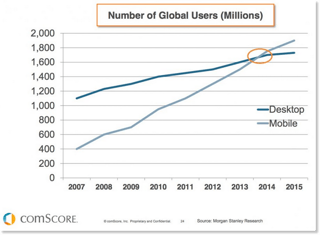 If you’ve had a serious conversation with an online marketing professional in the last two years, you’ve probably heard that more people are interacting with the web using their mobile devices, that mobile is getting more and more important, etc.
If you’ve had a serious conversation with an online marketing professional in the last two years, you’ve probably heard that more people are interacting with the web using their mobile devices, that mobile is getting more and more important, etc.
This article probably won’t surprise you, but it’s vital we all understand that the tipping point we’ve reached has far-reaching implications for your business website and how you interact with customers, with advantages for those who know how to take advantage of them, and disadvantages for those without mobile-optimized websites (and I say “mobile-optimized” as something more than “mobile-friendly”).
There are two main reasons we’ve passed the tipping point for mobile-first web design and optimization.
Mobile Usage Passed Desktop
The first reason is that mobile usage passed  desktop usage in 2014. The gap has continued to widen since then. That should be enough to get you to pay at least as much attention to mobile user experience as you do to your desktop users.
desktop usage in 2014. The gap has continued to widen since then. That should be enough to get you to pay at least as much attention to mobile user experience as you do to your desktop users.
Source: ComScore
Action Item: Pull out your smartphone right now and check out your website for two things:
1) Is it a good experience?
2) Are there effective, easy calls-to-action?
Google Uses Mobile-First Index
The second reason is that Google, the largest search engine by far, is going all-in for mobile. Their new index of the internet will be from a mobile device’s perspective (at the time of this article’s publication, they’re still working on it), and instead of using their previous desktop index to determine what sites deserve to rank in the search results, they’ll use their mobile-first index with somewhat different ranking factors.
According to Google, “Our algorithms will eventually primarily use the mobile version of a site’s content to rank pages from that site.” Those who don’t have a strategy for mobile could soon be missing out on 75% of their traffic and lead opportunities.
Here’s what you need to dominate on mobile:
Fast Websites
Mobile users want fast load times - around 1 second. Your website needs to be designed with this in mind. That’s also why Google has rolled out Accelerated Mobile Pages, a method of stripping elements unnecessary for mobile devices and preloading content for an experience that, to the user, will feel instantaneous. If you want the detailed explanation, look here.
Great User Experience
This should be obvious from a user perspective, but Google is looking at this as well and determining whether you deserve to rank. Pop-ups that you’ve got to close before reading content? No good. Small, hard to read font? Nope. A ton of in-line links? Another demerit, at least in initial versions of their algorithm. Exact factors will change, but a frustrating user experience will never get you the rankings you want.
Mobile-Optimized Calls to Action
This is less of a ranking factor and more of a commonly-missed opportunity for Conversion Rate Optimization. The calls to action you favor on the desktop (whether that’s an email sign-up or an invitation for a phone call) likely won’t be the highest-performing one on a mobile device.
Tapping a “Call Us” link on a smartphone is much easier than the desktop equivalent, while inputting email information on a mobile device is probably a lot more difficult to type in than on a full-size keyboard. Take that into account when planning your calls to action.
Eventually, everyone is going to have to get on the mobile-optimized bandwagon if they want to preserve their status-quo. But the companies who do so now will get to take advantage of all the opportunities in the meantime. And if you’re not trying to maximize your visitors, customers, leads, and, ultimately, profit, why did you read all the way through this article? ;)
We at i7 Marketing would love to help you craft a mobile lead-generation strategy.



Submit a Comment
Your email address will not be published. Required fields are marked *